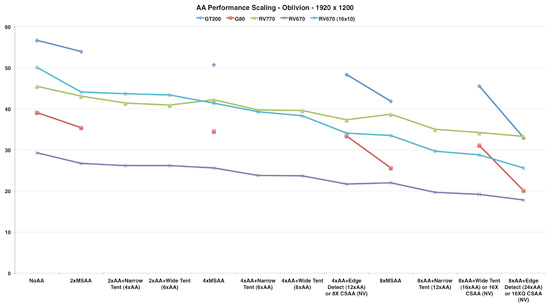The Radeon HD 4850 & 4870: AMD Wins at $199 and $299
by Anand Lal Shimpi & Derek Wilson on June 25, 2008 12:00 AM EST- Posted in
- GPUs
Fixing AMD's Poor AA Performance
Now that we have a new architecture from AMD with improved AA performance, it's time again to look at a comparison of all the different AA modes these cards offer. No new modes have been introduced since the R600 and G80 reviews, but AMD has completely rebuilt their ROPs with special attention to hardware based AA resolve. In R600, hardware resolve wasn't much faster than shader based resolve, but this time around, AA runs blazingly fast whether its on the dedicated resolve hardware or on the shader hardware (since their is so much more shader hardware now even shader based resolve gets a giant boost).
The first thing we will want to look at are the MSAA modes. These are the modes we absolutely recommend for use with AMD hardware as all their other filters essentially low-pass filter the entire image by blending in neighboring subpixels. In any case, the results are very impressive for RV770.
The RV670 at 19x12 was limited in some way other than AA (it really couldn't keep up), but at 16x10 we can get a better idea of relative impact of AA. And clearly the RV770 quite improves fall off with increasing AA levels over the previous generation. One special thing to note is that the RV770 does fall off very gracefully to 8xAA. Since the RV670, G80 and GT200 all have sharp drops in performance when moving up from 4xAA to 8xAA, the RV770 really shines here. In fact, the few tests we did with 8xAA paints the 4870 in a much better light relative to the GTX 280. Remember from our earlier architecture discussion that Oblivion is the game where the GT200 had the largest performance advantage over RV770.
While 8xAA performance is all well and good, the image quality difference is just not enough for us to recommend enabling it over increasing resolution (or better yet, pixel density on LCD panels -- hello display makers). For those with panels that don't go over 1280x1024, it would be better to spend the extra money on a large panel than a $300 graphics card. The application where we see 8xAA making the most sense is on 50+ HDTVs used as computer monitors where the pixels are just plain huge. For the majority of desktop users though 4xAA is where it's at.
We did test the performance of all the other modes as well. NVIDIA's CSAA modes are quite good (they actually improve image quality rather than degrade it), but again, stay away from anything but AMD's "box" filtered AA.
The RV770 actually shows a bigger performance hit from enabling their tent filters than RV670. This is likely because the filters are run on shader hardware in both cases while RV770 has faster hardware resolve that can be used for normal AA resolve. If RV670 resolves "box" filtered AA on the shader as well this would explain the flatter performance in that case. Even more so than the image quality question, the fact that they perform lower really should be the nail in the coffin for AMD's tent filter garbage.











215 Comments
View All Comments
NullSubroutine - Wednesday, June 25, 2008 - link
It scaled more than 100% in a few games?DerekWilson - Wednesday, June 25, 2008 - link
greater than 100% scaling is due to margin of error combination for both single card and dual card tests in the vast majority of cases.we also tested single card performance on an nvidia system and crossfire performance on an intel system, so the different computers will also add margin of error.
two card solutions generally don't scale at greater than 100% except in extraordinarily odd situations (where rebalancing loads might help with scaling on both individual cards -- but that's odd and rare).
Sind - Wednesday, June 25, 2008 - link
Why no 260 and 280 SLI?ImmortalZ - Wednesday, June 25, 2008 - link
Because, with that kind of money, one can an entire system with one 48xx :PAlso, page 10 appears to be broken.
Lifted - Wednesday, June 25, 2008 - link
No 260 or 280 SLI in the benchmarks, but they included them in the power charts. Odd.Anand Lal Shimpi - Wednesday, June 25, 2008 - link
The power data was simply taken from the GTX 280 review, we just added to the list.As for the GTX 280 SLI numbers, we didn't include them as it it's mostly out of the price range of the Radeon HD 4870 ($1300 vs. $600 for two 4870s). We can always go back and redo the graphs to include them if you guys would like, but in the interim I would suggest looking at the GTX review to get comparison numbers.
Take care,
Anand
DerekWilson - Wednesday, June 25, 2008 - link
we actually only have one GTX 260, so we can't test thatClauzii - Wednesday, June 25, 2008 - link
Yes, and the click to enlarge doesn't work.And believe it or not, posting right now from a AT page that looks like 1994...!
ImmortalZ - Wednesday, June 25, 2008 - link
Insert a buy in there. Need edit!TonyB - Wednesday, June 25, 2008 - link
but can it play crysis?